- Home
- Mobiles
- Mobiles Reviews
- HTC Butterfly review
HTC Butterfly review
By Anupam Saxena | Updated: 21 January 2014 15:47 IST
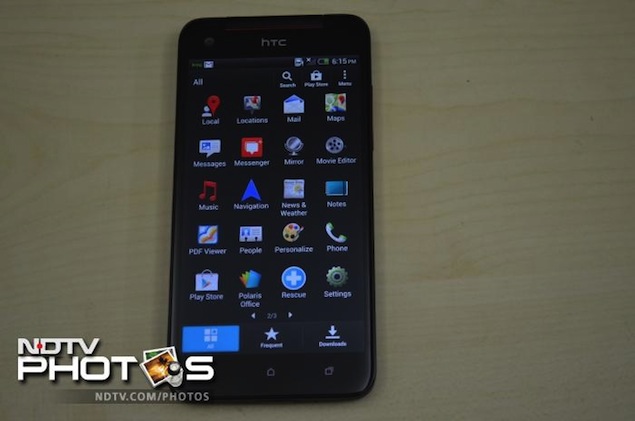
Click Here to Add Gadgets360 As A Trusted Source

Advertisement
The HTC Butterfly is the company's first 5-inch phone, and more importantly, the first phone to feature a 1080p display. The phone made its first appearance as the J Butterfly in Japan, and later in the US, as the Droid DNA, towards the end of 2012. Of course there were some differences in the hardware, but the basic design wasn't altered much.
The phone has made it to the Indian shores and interestingly even though it features a gigantic screen, HTC doesn't like to call it a phablet (a term popularly used for 5-inch+ phones). The phone boasts of high-end specifications but does that justify the Rs. 45,999 price tag of the phone? We try to find out.
Design/ Hardware
We found the design of the phone to be really attractive, and the first thing that one notices is that despite the big 5-inch screen the phone doesn't feel awkward to hold and has a thin profile.
The colour of our review unit was black, and it had red accents on the pseudo-grille (at the sides) and earpiece. HTC started deploying a polycarbonate build with the One X, and it has extended the same to the Butterfly. The phone has rounded corners and feels very thin. The back of the phone has a soft rubberised matte finish, and feels nice to hold. The 8-megapixel camera lens is located towards the top. Unlike the One X and One X+, the lens unit doesn't protrude out and is flush with the body of the phone, which makes it look more elegant.
A single LED flash is located just next to the lens. Like the One X, the phone doesn't have a removable back cover. There's glossy HTC branding engraved in the middle, and the Beats audio branding and the speaker outlet, towards the bottom of the phone.
The screen forms the largest part of the front, with the glass curving around the edges. HTC has used Corning Gorilla Glass 2, making the screen durable, and comparatively more resistant to scratches. There's a greyish brown metal strip right above the earpiece, which gives the phone a premium feel. The 2.1-megapixel front-shooter is located at the left side, below the earpiece. The front also features three capacitive touch buttons (Home, Back and Menu/ App Switcher) and their markings.
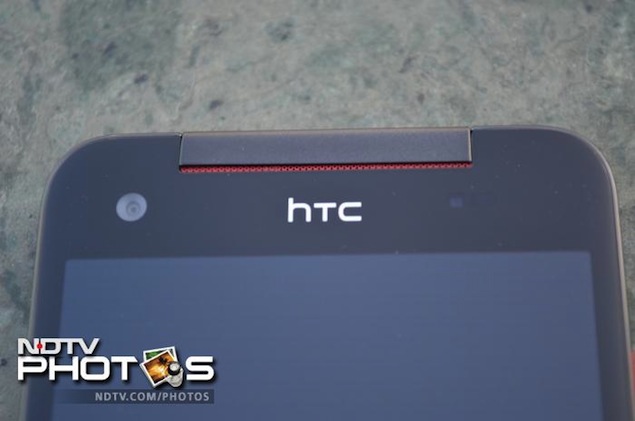 The bottom panel features a microphone and a rubber insert that hides the Micro-USB port. The right side features the volume rocker, which is also red in colour, just like the pseudo-side grille. There are no controls on the left side.
The bottom panel features a microphone and a rubber insert that hides the Micro-USB port. The right side features the volume rocker, which is also red in colour, just like the pseudo-side grille. There are no controls on the left side.
The top sports a secondary microphone and another insert that hides a slot for the Micro-SIM card and the microSD slot. One of the pain points of the phone is this very slot. It's really cumbersome and it took us a while to figure out the mechanism for placing our Micro-SIM card inside the phone. There's a pin-hole inside the slot which is easy to miss, and you need to insert a pin to eject the tray where the Micro-SIM is placed. HTC has not put any markings, so new users will, most likely, have no clue about the process, unless they read the accompanying user manual.
The power/screen lock button sits in in the middle. We felt that the placement of this button made the experience of unlocking the screen a bit cumbersome due to the size of the phone. We'd have preferred that the button was placed on the side. The phone also features a notification LED at the front (on the earpiece grill) as well as at the back (adjacent to the camera lens).
The phone is water resistant with an IPX-5 water resistance rating, so it can easily handle minor splashes and spills, not that we were tempted to put that to the test. The best part about the phone is its weight to body ratio, due to which the phone never feels bulky even with its large form factor.
Display
As we mentioned earlier, the 1080p display is the killer feature of the phone. The Butterfly sports a 5-inch Super LCD 3 display with Corning Gorilla Glass 2 and has a resolution of 1920x1080 pixels, packing-in 441 pixels per inch. The screen's pixel density is the highest among all flagship phones, and text and images appear extremely sharp. It's one of the most beautiful screens we've seen and reading text and browsing the web, especially make for extremely joyful experiences.
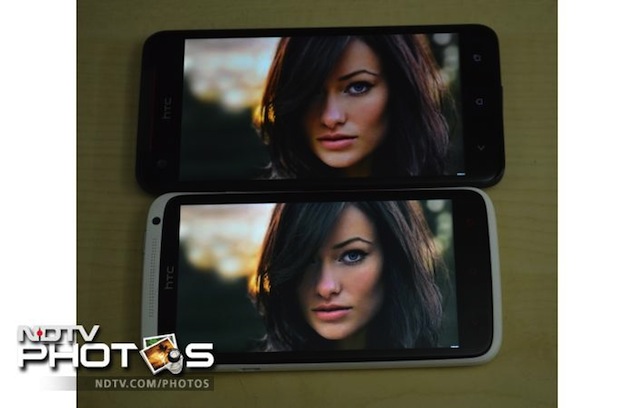
Camera
The HTC Butterfly sports a 8-megapixel rear camera with auto focus, LED flash, and BSI (back-illuminated) sensor, which as per the company, takes better low-light shots. It's a F2.0 aperture and 28mm lens. The phone has a dedicated HTC ImageChip, company's own Image Signal processor (ISP), which allows users to take faster shots (the camera's startup time is 0.7 seconds and it can take one shot in 0.2 seconds) and better shots in all light conditions and movement.
 The phone also boasts of a smart flash that adjusts the intensity of the camera flash as per distance from the subject. The phone supports 1080p HD video recording, and slow motion video capture. The phone also allows users to click 6-megapixel photos while they're shooting a video, which is pretty impressive compared to other phones.
The phone also boasts of a smart flash that adjusts the intensity of the camera flash as per distance from the subject. The phone supports 1080p HD video recording, and slow motion video capture. The phone also allows users to click 6-megapixel photos while they're shooting a video, which is pretty impressive compared to other phones.
The Butterfly also features a 2.1-megapixel front camera that can take wide-angle shots, and facilitates 1080p video calling.
As with other Android devices from the company, HTC integrates its own Camera app, that allows users to select different scene settings (among Normal, Landscape, Portrait, Backlight, Night, Text and Macro) for still captures; switch between HDR, Panorama and Group portrait modes, and choose the slow motion video mode. It also allows users to put a self timer (ranging from 2 to 10 seconds), select the resolution, video quality, review duration, image adjustments (for exposure, contrast, saturation and sharpness), ISO and White Balance settings. One can also choose to disable Continuous Shooting or restrict it to 20 frames.
In addition to these, there are other options related to face and smile detection, geo-tagging, shutter sound and a grid interface. A video stabilisation setting is also available. Interestingly, the camera app also offers lenses for adding effects like Sepia, Negative, Vintage, amongst many others, even before one clicks a picture. HTC has also added a sightseeing mode, which simply means that if you lock the phone in the camera app, you'd find it open when you press the same key again (no need to unlock the screen).

We found the camera to be feature rich, and at the same time, pretty capable. Although, a lot of these features are available even on the HTC One X+ and the 8x, they're really snappy on the Butterfly. The quality of both indoor and outdoor shots was good, with the camera delivering well on colour reproduction, sharpness and detail. We also took a few night-mode shots, where the phone disables flash, and found that shots were above average, although a hint of graininess was still visible. The phone's video recording capabilities are also good, as HTC incorporates a video stabilisation engine for smooth captures.
Software/ User Interface
The HTC Butterfly runs Android 4.1.1 Jelly Bean and Sense 4+, HTC's own UI that includes some custom apps in addition to a skinned (deeply integrated) interface. While some people prefer stock Android over any kind of skinning, we feel that the Sense is one of the better skinning solutions, and looks great on the full-HD screen.
The phone offers scenes and skins (including a Butterfly Scene) for theming. It also offers an 'App & Shortcuts' widget, which we'd first seen on the HTC Rhyme, that lets users put four app launchers or other shortcuts on the home screen. There are several weather and clock widgets for the home screen, and the familiar ring-like lock screen which allows users to unlock the screen and jump straight into the phone, Mail, Messages or Camera app.
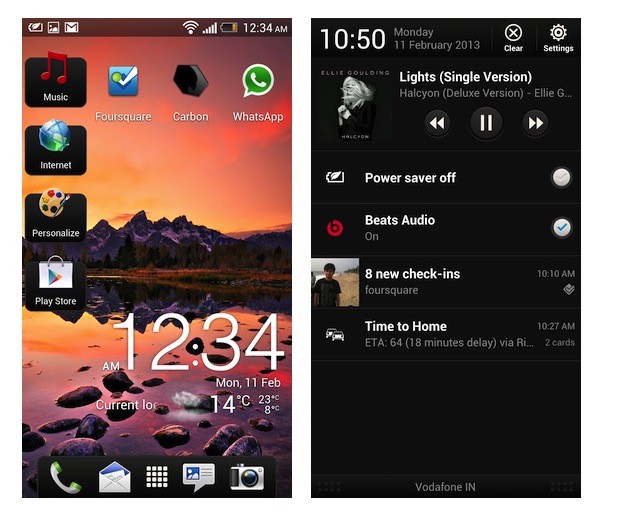 One can navigate the phone through the capacitive touch buttons for going to the Home screen and for going Back. The third button is configurable and can be used as a Menu plus App Switcher or just as an App Switcher (the behaviour can be chosen in the phone settings under Display, gestures Gestures & buttonsButtons). HTC has also skinned the app switcher with a 3D UI through which running apps can be dismissed by pulling it out from the group.
One can navigate the phone through the capacitive touch buttons for going to the Home screen and for going Back. The third button is configurable and can be used as a Menu plus App Switcher or just as an App Switcher (the behaviour can be chosen in the phone settings under Display, gestures Gestures & buttonsButtons). HTC has also skinned the app switcher with a 3D UI through which running apps can be dismissed by pulling it out from the group.
HTC also offers a 3-finger output gesture that, if enabled, allows users to turn on HTC Media Link HD output to TV.
The HTC Butterfly allows the use of certain gestures to control alerts. For instance, one can choose to reduce ringer volume when the phone is moved or can flip the phone for turning on speakerphone. There's also a Power Saver mode that can check CPU usage, reduce screen brightness, turn off vibration and disable data use when the screen is turned off. The mode is automatically invoked when the phone's running out of battery juice.
The notification tray features a settings shortcut and a clear all notifications button, along with expandable notifications (expanded with the two finger pull gesture). Android 4.1 Jelly Bean also brings in Google Now, which after initialising for the first time, can be accessed directly by long pressing the home button or through the Search widget.
For the uninitiated, Google Now is a voice based information assistant and an extension of Google search. You can ask questions and the tool returns answers or search results. It uses 'cards' which are essentially small boxes that offer different sets of information ranging from weather forecast, directions, traffic information, scores, appointments, and currency conversion, among others. Google Now collects information based on the user's behavior, location, and even e-mail, to offer information automatically.
HTC's Gallery app allows users to browse images and videos on the phone in addition to the ones present on online services like Dropbox, Facebook, Flickr, Picasa, and SkyDrive. It also has a shortcut to the Camera app. The Gallery app allows browsing based on Events (Time, Date and Place) and Albums. The messaging app offers some interesting features, including a secure inbox, a password protected folder for storing confidential messages, and the option to block messages from select senders. The messaging interface is also customisable with different colour options for message bubbles and the ability to choose a background image.
HTC also offers its own Keyboard, which also offers word predictions, option to add words to a personal dictionary, and a 'Swipe' like keyboard, which HTC calls a Trace keyboard, that allows users to slide fingers over letters to key-in words. The keyboard was a breeze to use and it didn't feel awkward while typing with a single hand on Butterfly's gigantic screen.
The app launcher is divided in three tabs - All, Frequent and Downloads. Apps can be sorted alphabetically, and according to recency. App search is integrated with the launcher.
Performance/Battery Life
The Butterfly is powered by a 1.5GHz Qualcomm S4 Pro quad-core processor with 2GB RAM onboard, and an Adreno 320 chip for processing graphics. There is 16GB of internal storage, which is expandable up to 32GB via a microSD card.
With Android 4.1 Jelly Bean, the overall experience of navigation through the interface was extremely impressive, thanks to Project Butter and all the power under the hood. We did not experience any lag at all while launching apps, playing games, scrolling web pages or switching between apps. It's safe to say that performance wise the Butterfly is the hands-down winner, compared to other Android flagships.
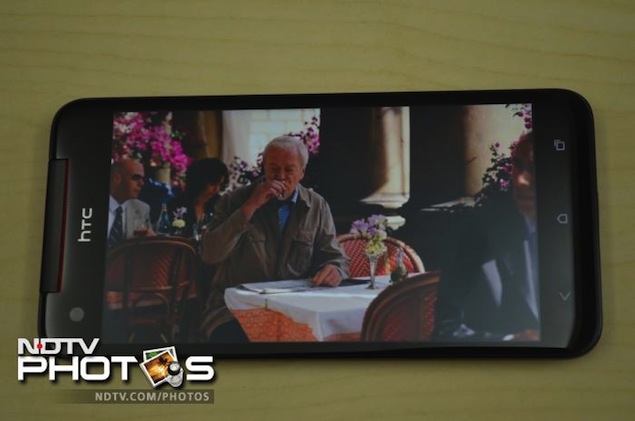 We were able to play full-HD clips, though some formats including .mov, were not supported (this can be fixed by the use of third party apps). The speaker on the phone delivers good quality sound at high volume levels. The phone also supports Beats audio when you plug-in the headphones, which boosts bass and offers a much richer sound. Call quality was good.
We were able to play full-HD clips, though some formats including .mov, were not supported (this can be fixed by the use of third party apps). The speaker on the phone delivers good quality sound at high volume levels. The phone also supports Beats audio when you plug-in the headphones, which boosts bass and offers a much richer sound. Call quality was good.
The Butterfly offers Chrome in addition to the default browser. The default browser also allows users to turn on Adobe flash for viewing Flash content. It also offers a reader mode for reading text heavy web pages.
The phone comes with a 2020mAh battery, and in our usage, it lasted us a full day. We charged the phone in the morning (at around 9am), and with medium to heavy usage, including 1-1.5 hours of phone calls, two e-mail accounts with push notifications, playing some music, Twitter notifications and WhatsApp chats, the phone lasted a good 13-14 hours. It's worth pointing out that we had turned off Wi-Fi and auto-brightness, and the phone was hooked to a 3G network with the screen brightness at the highest level. Altering these settings might help in running the phone for a longer duration, depending on your usage pattern.
It's worth pointing out that the phone comes with neither NFC nor 4G/ LTE, which probably doesn't mean much in India at this point in time, but may be a deal breaker for those wanting their Rs. 45,000 purchases to be future-ready (not that we'd blame them!).
Verdict
The HTC Butterfly is the most expensive Android smartphone in the market. It's also one of the best Android phones we've used combining a major set of features, a brilliant HD screen and great ergonomics and build quality. We feel that the asking price of Rs. 45,999, is a bit on the higher side, if you compare it to flagships from other brands. Having said that, the phone outperforms all its rivals and the full-HD display is unique.
If you're someone who likes owning the best phone, no matter what, we have no hesitation recommending the HTC Butterfly. The phone matches the iPhone 5 not only in price, but thanks to the enhancements in Jelly Bean, in the overall experience as well.
Having said that, not everyone would be comfortable putting down this big an amount for a smartphone, and such people may consider other flagships like the Samsung Galaxy S III, which are now available at attractive discounts compared to their launch price. Large screen enthusiasts may prefer the Galaxy Note II.
Before we part, we can surely say that having experienced a full-HD display, we can't wait for other manufacturers to ship their own full-HD smartphones. The Xperia Z is expected to hit the Indian shores in March, and HTC's M7 aka HTC One is set to be unveiled as well. It's safe to say, as far as mobiles are concerned, the future's HD!

HTC Butterfly: First look
The phone has made it to the Indian shores and interestingly even though it features a gigantic screen, HTC doesn't like to call it a phablet (a term popularly used for 5-inch+ phones). The phone boasts of high-end specifications but does that justify the Rs. 45,999 price tag of the phone? We try to find out.
Design/ Hardware
We found the design of the phone to be really attractive, and the first thing that one notices is that despite the big 5-inch screen the phone doesn't feel awkward to hold and has a thin profile.
The colour of our review unit was black, and it had red accents on the pseudo-grille (at the sides) and earpiece. HTC started deploying a polycarbonate build with the One X, and it has extended the same to the Butterfly. The phone has rounded corners and feels very thin. The back of the phone has a soft rubberised matte finish, and feels nice to hold. The 8-megapixel camera lens is located towards the top. Unlike the One X and One X+, the lens unit doesn't protrude out and is flush with the body of the phone, which makes it look more elegant.
A single LED flash is located just next to the lens. Like the One X, the phone doesn't have a removable back cover. There's glossy HTC branding engraved in the middle, and the Beats audio branding and the speaker outlet, towards the bottom of the phone.
The screen forms the largest part of the front, with the glass curving around the edges. HTC has used Corning Gorilla Glass 2, making the screen durable, and comparatively more resistant to scratches. There's a greyish brown metal strip right above the earpiece, which gives the phone a premium feel. The 2.1-megapixel front-shooter is located at the left side, below the earpiece. The front also features three capacitive touch buttons (Home, Back and Menu/ App Switcher) and their markings.
The top sports a secondary microphone and another insert that hides a slot for the Micro-SIM card and the microSD slot. One of the pain points of the phone is this very slot. It's really cumbersome and it took us a while to figure out the mechanism for placing our Micro-SIM card inside the phone. There's a pin-hole inside the slot which is easy to miss, and you need to insert a pin to eject the tray where the Micro-SIM is placed. HTC has not put any markings, so new users will, most likely, have no clue about the process, unless they read the accompanying user manual.
The power/screen lock button sits in in the middle. We felt that the placement of this button made the experience of unlocking the screen a bit cumbersome due to the size of the phone. We'd have preferred that the button was placed on the side. The phone also features a notification LED at the front (on the earpiece grill) as well as at the back (adjacent to the camera lens).
The phone is water resistant with an IPX-5 water resistance rating, so it can easily handle minor splashes and spills, not that we were tempted to put that to the test. The best part about the phone is its weight to body ratio, due to which the phone never feels bulky even with its large form factor.
Display
As we mentioned earlier, the 1080p display is the killer feature of the phone. The Butterfly sports a 5-inch Super LCD 3 display with Corning Gorilla Glass 2 and has a resolution of 1920x1080 pixels, packing-in 441 pixels per inch. The screen's pixel density is the highest among all flagship phones, and text and images appear extremely sharp. It's one of the most beautiful screens we've seen and reading text and browsing the web, especially make for extremely joyful experiences.
Comparing screens: HTC Butterfly vs HTC One X+
While the difference may not be visible at first, after using the phone for a while, you'll be able to see the difference between a 720p screen such as that of the One X+ and the Butterfly's full HD screen. However, our only gripe with the screen was that it was very reflective. The under sun visibility could also have been a bit better if you compare it to the iPhone. The viewing angles on the phone, however, are excellent.Camera
The HTC Butterfly sports a 8-megapixel rear camera with auto focus, LED flash, and BSI (back-illuminated) sensor, which as per the company, takes better low-light shots. It's a F2.0 aperture and 28mm lens. The phone has a dedicated HTC ImageChip, company's own Image Signal processor (ISP), which allows users to take faster shots (the camera's startup time is 0.7 seconds and it can take one shot in 0.2 seconds) and better shots in all light conditions and movement.
The Butterfly also features a 2.1-megapixel front camera that can take wide-angle shots, and facilitates 1080p video calling.
As with other Android devices from the company, HTC integrates its own Camera app, that allows users to select different scene settings (among Normal, Landscape, Portrait, Backlight, Night, Text and Macro) for still captures; switch between HDR, Panorama and Group portrait modes, and choose the slow motion video mode. It also allows users to put a self timer (ranging from 2 to 10 seconds), select the resolution, video quality, review duration, image adjustments (for exposure, contrast, saturation and sharpness), ISO and White Balance settings. One can also choose to disable Continuous Shooting or restrict it to 20 frames.
In addition to these, there are other options related to face and smile detection, geo-tagging, shutter sound and a grid interface. A video stabilisation setting is also available. Interestingly, the camera app also offers lenses for adding effects like Sepia, Negative, Vintage, amongst many others, even before one clicks a picture. HTC has also added a sightseeing mode, which simply means that if you lock the phone in the camera app, you'd find it open when you press the same key again (no need to unlock the screen).
A macro shot taken with the Butterfly; A low-light shot taken with the phone
We found the camera to be feature rich, and at the same time, pretty capable. Although, a lot of these features are available even on the HTC One X+ and the 8x, they're really snappy on the Butterfly. The quality of both indoor and outdoor shots was good, with the camera delivering well on colour reproduction, sharpness and detail. We also took a few night-mode shots, where the phone disables flash, and found that shots were above average, although a hint of graininess was still visible. The phone's video recording capabilities are also good, as HTC incorporates a video stabilisation engine for smooth captures.
Software/ User Interface
The HTC Butterfly runs Android 4.1.1 Jelly Bean and Sense 4+, HTC's own UI that includes some custom apps in addition to a skinned (deeply integrated) interface. While some people prefer stock Android over any kind of skinning, we feel that the Sense is one of the better skinning solutions, and looks great on the full-HD screen.
The phone offers scenes and skins (including a Butterfly Scene) for theming. It also offers an 'App & Shortcuts' widget, which we'd first seen on the HTC Rhyme, that lets users put four app launchers or other shortcuts on the home screen. There are several weather and clock widgets for the home screen, and the familiar ring-like lock screen which allows users to unlock the screen and jump straight into the phone, Mail, Messages or Camera app.
HTC also offers a 3-finger output gesture that, if enabled, allows users to turn on HTC Media Link HD output to TV.
The HTC Butterfly allows the use of certain gestures to control alerts. For instance, one can choose to reduce ringer volume when the phone is moved or can flip the phone for turning on speakerphone. There's also a Power Saver mode that can check CPU usage, reduce screen brightness, turn off vibration and disable data use when the screen is turned off. The mode is automatically invoked when the phone's running out of battery juice.
The notification tray features a settings shortcut and a clear all notifications button, along with expandable notifications (expanded with the two finger pull gesture). Android 4.1 Jelly Bean also brings in Google Now, which after initialising for the first time, can be accessed directly by long pressing the home button or through the Search widget.
For the uninitiated, Google Now is a voice based information assistant and an extension of Google search. You can ask questions and the tool returns answers or search results. It uses 'cards' which are essentially small boxes that offer different sets of information ranging from weather forecast, directions, traffic information, scores, appointments, and currency conversion, among others. Google Now collects information based on the user's behavior, location, and even e-mail, to offer information automatically.
HTC's Gallery app allows users to browse images and videos on the phone in addition to the ones present on online services like Dropbox, Facebook, Flickr, Picasa, and SkyDrive. It also has a shortcut to the Camera app. The Gallery app allows browsing based on Events (Time, Date and Place) and Albums. The messaging app offers some interesting features, including a secure inbox, a password protected folder for storing confidential messages, and the option to block messages from select senders. The messaging interface is also customisable with different colour options for message bubbles and the ability to choose a background image.
HTC also offers its own Keyboard, which also offers word predictions, option to add words to a personal dictionary, and a 'Swipe' like keyboard, which HTC calls a Trace keyboard, that allows users to slide fingers over letters to key-in words. The keyboard was a breeze to use and it didn't feel awkward while typing with a single hand on Butterfly's gigantic screen.
The app launcher is divided in three tabs - All, Frequent and Downloads. Apps can be sorted alphabetically, and according to recency. App search is integrated with the launcher.
Performance/Battery Life
The Butterfly is powered by a 1.5GHz Qualcomm S4 Pro quad-core processor with 2GB RAM onboard, and an Adreno 320 chip for processing graphics. There is 16GB of internal storage, which is expandable up to 32GB via a microSD card.
With Android 4.1 Jelly Bean, the overall experience of navigation through the interface was extremely impressive, thanks to Project Butter and all the power under the hood. We did not experience any lag at all while launching apps, playing games, scrolling web pages or switching between apps. It's safe to say that performance wise the Butterfly is the hands-down winner, compared to other Android flagships.
The Butterfly offers Chrome in addition to the default browser. The default browser also allows users to turn on Adobe flash for viewing Flash content. It also offers a reader mode for reading text heavy web pages.
The phone comes with a 2020mAh battery, and in our usage, it lasted us a full day. We charged the phone in the morning (at around 9am), and with medium to heavy usage, including 1-1.5 hours of phone calls, two e-mail accounts with push notifications, playing some music, Twitter notifications and WhatsApp chats, the phone lasted a good 13-14 hours. It's worth pointing out that we had turned off Wi-Fi and auto-brightness, and the phone was hooked to a 3G network with the screen brightness at the highest level. Altering these settings might help in running the phone for a longer duration, depending on your usage pattern.
It's worth pointing out that the phone comes with neither NFC nor 4G/ LTE, which probably doesn't mean much in India at this point in time, but may be a deal breaker for those wanting their Rs. 45,000 purchases to be future-ready (not that we'd blame them!).
Verdict
The HTC Butterfly is the most expensive Android smartphone in the market. It's also one of the best Android phones we've used combining a major set of features, a brilliant HD screen and great ergonomics and build quality. We feel that the asking price of Rs. 45,999, is a bit on the higher side, if you compare it to flagships from other brands. Having said that, the phone outperforms all its rivals and the full-HD display is unique.
If you're someone who likes owning the best phone, no matter what, we have no hesitation recommending the HTC Butterfly. The phone matches the iPhone 5 not only in price, but thanks to the enhancements in Jelly Bean, in the overall experience as well.
Having said that, not everyone would be comfortable putting down this big an amount for a smartphone, and such people may consider other flagships like the Samsung Galaxy S III, which are now available at attractive discounts compared to their launch price. Large screen enthusiasts may prefer the Galaxy Note II.
Before we part, we can surely say that having experienced a full-HD display, we can't wait for other manufacturers to ship their own full-HD smartphones. The Xperia Z is expected to hit the Indian shores in March, and HTC's M7 aka HTC One is set to be unveiled as well. It's safe to say, as far as mobiles are concerned, the future's HD!
HTC Butterfly: First look
Comments
Catch the latest from the Consumer Electronics Show on Gadgets 360, at our CES 2026 hub.
Further reading:
Android, Butterfly, HTC, HTC Butterfly, HTC Butterfly price, HTC Butterfly price in India, HTC Butterfly review, HTC mobiles
Related Stories
Popular on Gadgets
- Samsung Galaxy Unpacked 2025
- ChatGPT
- Redmi Note 14 Pro+
- iPhone 16
- Apple Vision Pro
- Oneplus 12
- OnePlus Nord CE 3 Lite 5G
- iPhone 13
- Xiaomi 14 Pro
- Oppo Find N3
- Tecno Spark Go (2023)
- Realme V30
- Best Phones Under 25000
- Samsung Galaxy S24 Series
- Cryptocurrency
- iQoo 12
- Samsung Galaxy S24 Ultra
- Giottus
- Samsung Galaxy Z Flip 5
- Apple 'Scary Fast'
- Housefull 5
- GoPro Hero 12 Black Review
- Invincible Season 2
- JioGlass
- HD Ready TV
- Laptop Under 50000
- Smartwatch Under 10000
- Latest Mobile Phones
- Compare Phones
Latest Gadgets
- OPPO Reno 15 FS
- Red Magic 11 Air
- Honor Magic 8 RSR Porsche Design
- Honor Magic 8 Pro Air
- Infinix Note Edge
- Lava Blaze Duo 3
- Tecno Spark Go 3
- iQOO Z11 Turbo
- Lenovo Yoga Slim 7x (2025)
- Lenovo Yoga Slim 7a
- Lenovo Idea Tab Plus
- Realme Pad 3
- Moto Watch
- Garmin Quatix 8 Pro
- Haier H5E Series
- Acerpure Nitro Z Series 100-inch QLED TV
- Asus ROG Ally
- Nintendo Switch Lite
- Haier 1.6 Ton 5 Star Inverter Split AC (HSU19G-MZAID5BN-INV)
- Haier 1.6 Ton 5 Star Inverter Split AC (HSU19G-MZAIM5BN-INV)
© Copyright Red Pixels Ventures Limited 2026. All rights reserved.


















